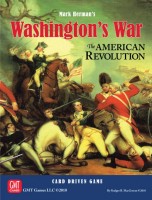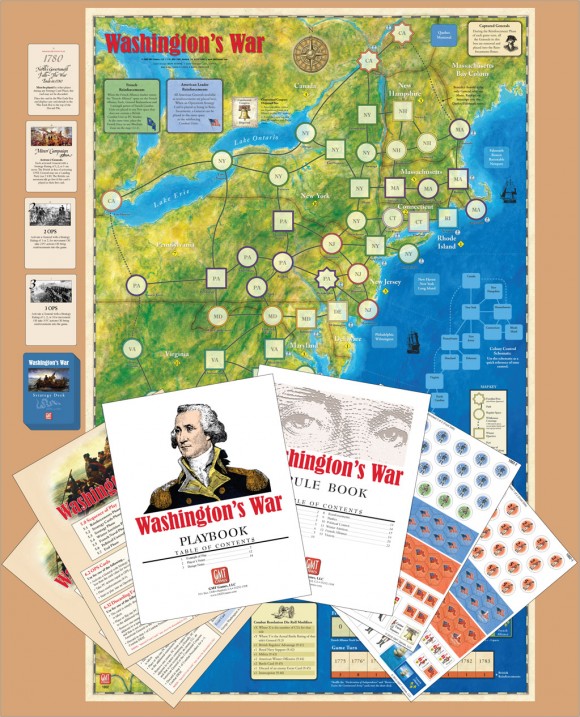
Washington’s War
Washington's War is a card-driven game on the American Revolution. It pits the forces of King George III against the American colonists as they fight for their independence. In Washington’s War, you assume the role of either:
- the King of England as he tries to bring his rebellious colonies back into the Empire, while at the same time dealing with a global war against ancient enemies bent on revenge for their losses in the Seven Years War; OR
- the Continental Congress as they battle the forces of England, while trying to rally their countrymen to the cause of liberty.

Washington's War is not just a re-tread of Mark Herman's earlier design on the same subject, but a true re-design that is keeping the basic feel while simplifying and speeding up what was already a fast paced game. Washington's War features a dice-driven combat system that quickly resolves combat and is very friendly to Internet play. The game also features a new CDG discard mechanic that enables a player to play a discarded event for the cost of an operations card. Now unusual card distributions create challenges and not insurmountable barriers to push your strategy forward. Washington's War is being broadly tested on the Internet to give players a voice and a source of input prior to publication. What was old is new again.... Be the man on the white horse and forge a nation or save an empire.
User Reviews (1)
Add a Review for "Washington’s War"
You must be logged in to add a review.


INTRODUCTION
Washington’s War, designed by Mark Herman, is a refined version of We The People, which was the first Card Driven Wargame (CDW). Washington’s War covers the American Revolution from beginning to end. Players engage in a political and military struggle for control of the American colonies. The object of the game is to control a number of colonies to meet your victory condition. The conflict is well represented in card events and other game mechanisms. Washington’s War is a two player game which plays in about 90 minutes.
COMPONENTS
The components are excellent. The board is mounted on thick cardboard and colorful. There are thick cardboard counters which present information well, plastic stands, and cardstock player aids. The cards are fairly durable and have nondescript artwork depicting the time period. The rulebook is 23 pages long, very well organized and contains many examples. The rulebook is a little wordy but still fairly well written. The game also includes a playbook which contains an extended example of play and strategy tips. Very helpful!
SET UP
Set-up for Washington’s War is very quick and easy. Two game turn markers, and a few military units and Political Control markers are placed on the board, and the deck is shuffled. Cards are dealt and play begins, that’s it!
GAME MECHANICS
Washington’s War is played in a series of turns in which each turn represents a year. The game begins in 1775 and must absolutely end after the 1783 turn. The game rarely lasts until the 1783 turn as there is a variable end mechanic in the game. Each game turn or year consists of the following seven phases:
1. Reinforcement
2. Strategy Cards
3. Strategy
4. Winter Attrition
5. French Naval
6. Political Control
7. End
REINFORCEMENT
Any captured generals are returned to their respective reinforcement box. The British player places Combat Units (CUs) equal to the number listed for the current turn on the turn track in his reinforcement box. CUs are a generic representation of military units used in the game; types of units such as artillery, cavalry and infantry are NOT used.
STRATEGY CARDS
The deck is shuffled if it is depleted or if a card event requires shuffling. Each player is dealt seven cards.
STRATEGY
Players alternate playing Strategy Cards until all cards have been played. The British player may choose to go first if he has a Major or Minor Campaign card. Otherwise the American player chooses who will go first.
Strategy cards can be used as either an OPs Card or an Event Card, but not both. If used as an Event Card, the player carries out the specific instructions for the event on the card.
If a card is used as an OPs card, then the player uses the numerical rating (1 to 3) in the upper left hand corner of the card to perform an action. Playing a Strategy Card as an OPs Card allows the player to do ONE of the following:
A) Place Political Control markers (PC markers) equal to the OPs number. The American player can place PC markers in any empty space or a space which contains a Friendly general or CU. The British player can place PC markers in an empty space adjacent to a space with an existing British PC marker or a space containing a British Army.
B) Activate a general with a Strategy Rating equal to or less than the OPs number. Generals can move up to four spaces with up to 5 CUs. British generals can also make a naval move from port to port.
C) Bring reinforcements into the game. The American player can bring reinforcements in the game up to two times per game turn and the British player can bring reinforcements in the game only once per game turn. The American player can bring in one general and CUs up to the OPs number, and place them in any neutral or friendly controlled space. The British player can bring in one general and CUs up to the maximum in the British reinforcement box, and place them in any neutral or friendly controlled port space.
During the Strategy Phase, while units are moving there are a few actions which can occur:
Interception: An American Army can attempt to intercept a British Army which enters an adjacent space. The American Army successfully intercepts on a 1D6 roll equal to or less than the American general’s Agility Rating. If the interception fails, then the British Army continues movement. A successful interception allows the American Army to be placed in the space prior to the British Army entering the space, causing an immediate battle.
Retreat Before Battle: An American Army may attempt to retreat instead of fighting a battle. The retreat attempt is successful on a 1D6 roll equal to or less than the American general’s Agility Rating. A successful retreat allows the American Army to move to any adjacent friendly controlled space as long as it is not the space from which the British Army attacked. A successful retreat also causes the British Army to end its movement.
Battle: A battle occurs whenever an Army enters a space containing enemy CUs and the defender cannot be overrun and cannot or chooses not to Retreat Before Battle. First the attacker, then the defender declare if they are playing a battle card. Then each player rolls 1D6 to determine the Battle Rating of their respective general. On a roll of 4-6 the general has his full Battle Rating as shown on general’s playing piece. On a roll of 1-3 the general has half (rounded down) the Battle Rating shown on the playing piece. Players then determine their Die Roll Modifiers (DRM) which comes from the number of CUs, Battle Cards, General’s Battle Rating, successfully intercepting, Militia bonus and British special bonuses from their naval and regular troop advantages. Once each player determines their respective DRM, they each roll a 1D6 and add the DRM to it. The higher total wins the battle with ties going to the ATTACKER. A separate roll is made afterward to determine battle casualties.
WINTER ATTRITION
CUs are checked for possible winter attrition losses. Each British army which is not in a winter quarters space (square or star outline on map) or south of the Winter Attrition Line loses one-half (rounding down) of its CUs. Each American army loses one-half (rounding down) of its CUs. Washington’s army is treated similar to the British.
FRENCH NAVAL
If the French Alliance is in effect, then the American player can relocate the French navy to any blockade zone. The British lose all naval advantages in the blockaded zone.
POLITICAL CONTROL
The American player places the Continental Congress if it was dispersed during the Strategy Phase.
Each player places PC markers in spaces containing his Armies.
Remove isolated PC markers. An American PC marker is isolated if a path from the marker cannot be traced to either an American or French general, an American or French CU, the Continental Congress or a neutral space. A British PC marker is isolated if a path from the marker cannot be traced to a British CU, neutral space or port.
END
Check for automatic victory. An American automatic victory occurs if there are no British CUs in the 13 colonies. A British automatic victory occurs if there are no American or French CUs on the map.
Check if Lord North’s government has fallen. The game ends if the “Lord North’s Government Falls – War Ends” Strategy Card in the War Ends box states the game ends on this turn or an earlier turn. If Lord North’s government falls then the game ends and victory conditions are checked by counting each side’s controlled colonies (including Canada). The Americans win if they control 7 or more colonies. The British win if they control 6 or more colonies OR if both the Americans and British achieve their victory condition.
If the game does not end, then all OPs cards in the Reinforcement boxes are discarded, the Game Turn marker is advanced to the next year and a new game turn begins.
THOUGHTS
Washington’s War is a very accessible CDW and a great starting place for those who are new to CDWs. It is easy to learn and play; although it may take a play or two to fully grasp strategies. The game plays quickly with little down time between turns. Obviously player interaction is heavy so players are engaged even when it is not their turn.
If you’re looking for a historical simulation of the American Revolution you won’t find it in Washington’s War. Significant people, places and events are in the game. However, you won’t fight the same battles or play events along the same timeline or even at all. This makes the game very replayable.
Washington’s War is a lot of fun and has a flare for the dramatics. The political battle can be fierce while the military battles intensify in the later turns. I have had many games decided in epic fashion on the last card play of the game! Washington’s War would make an excellent addition to your collection and I highly recommend it to avid and power gamers.